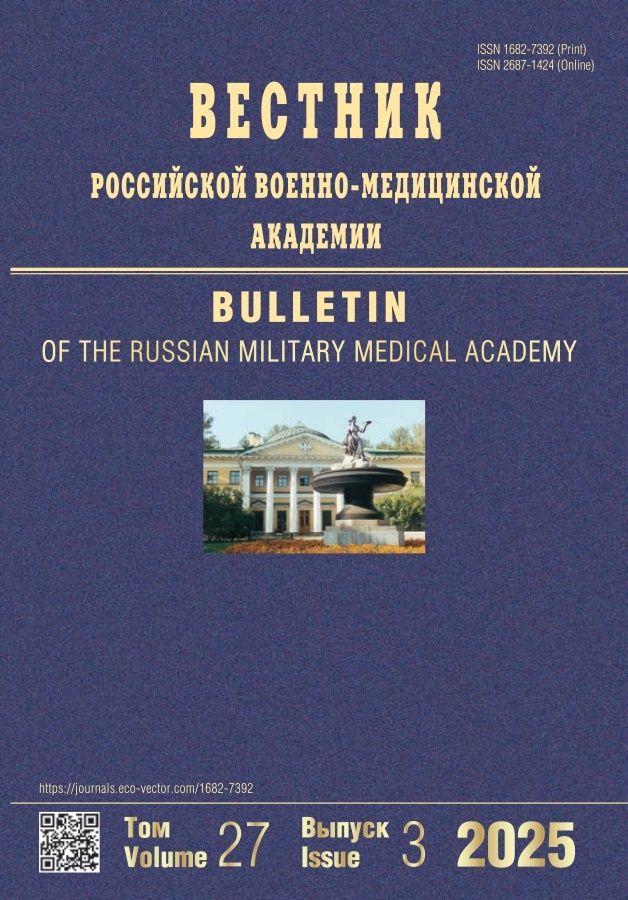Возможности биоимпедансного анализа в диагностике ожирения
- Авторы: Нагибович ОА1, Смирнова ГА1, Андриянов АИ1, Кравченко ЕВ1, Коновалова ИА1
-
Учреждения:
- Военно-медицинская академия им. С.М. Кирова
- Выпуск: Том 20, № 2 (2018)
- Страницы: 182-186
- Раздел: Статьи
- URL: https://journals.rcsi.science/1682-7392/article/view/12321
- DOI: https://doi.org/10.17816/brmma12321
- ID: 12321
Цитировать
Полный текст
Аннотация
Полный текст
Открыть статью на сайте журналаОб авторах
О А Нагибович
Военно-медицинская академия им. С.М. КироваСанкт-Петербург
Г А Смирнова
Военно-медицинская академия им. С.М. Кирова
Email: smirnova2006@gmail.com
Санкт-Петербург
А И Андриянов
Военно-медицинская академия им. С.М. КироваСанкт-Петербург
Е В Кравченко
Военно-медицинская академия им. С.М. КироваСанкт-Петербург
И А Коновалова
Военно-медицинская академия им. С.М. КироваСанкт-Петербург
Список литературы
- Бойцов, С.А. Профилактика хронических неинфекционных заболеваний: рекомендации / C.А. Бойцов. - М.: ГНИЦПМ, 2013. - 128 с.
- Бутрова, С.А. От эпидемии ожирения к эпидемии сахарного диабета / С.А. Бутрова // Международный эндокринологи- ческий журнал. - 2013. - № 3. - С. 19-24.
- Григорьев, С.Г. Роль и место логистической регрессии и roc- анализа в решении медицинских диагностических задач / С.Г. Григорьев, Ю.В. Лобзин, Н.В. Скрипченко // Журнал инфектологии. - 2016. - Т. 8, № 4.- С. 36-45.
- Мартиросов, Э.Г. Применение антропологических мето- дов в спорте, спортивной медицине и фитнесе / Э.Г. Мартиросов, С.Г. Руднев - М.: Физическая культура, 2010. - 120 с.
- Николаев, Д.В. Лекции по биоимпедансному составу тела человека / Д.В. Николаев, С.П. Щелыкалина. - М.: РИО ЦНИИОИЗ МЗ РФ, 2016. - 152 с.
- Смирнова, Г.А. Взаимосвязь заболеваемости курсантов Во- енно-медицинской академии с их функциональным состо- янием, статусом питания и успеваемостью / Г.А. Смирнова // Вестн. Росс. воен.-мед. акад. - Прилож. - 2014. - № 2 (46). - С. 39-40.
- Файнзильберг, Л.С. Гарантированная оценка эффективности диагностических тестов на основе усиленного ROC-анализа / Л.С. Файнзильберг, Т.Н. Жук // Управляющие системы и машины. - 2009. - № 5. - С. 3-13.
- Fawcett, T. ROC Graphs: Notes and Practical Considerations for Researchers. - Kluwer Acad. Publ. - 2004. - 38 p.
- Fidanza, F. Body fat in adult man: semicentenary of fat density and skinfolds / F. Fidanza // Acta Diabetol, 2003. - Vol. 40. - P. 242-248.
- Goodpaster, B.H. Metabolic Flexibility in Health and Disease / B.H. Goodpaster, L.M. Sparks // Cell Metab. - 2017. - Vol. 2, № 25 (5). - P. 1027-1036.
- Jaffrin, M.Y. Body composition determination by bioimpedance: an update / M.Y. Jaffrin // Curr. Opin. Clin. Nutr. Metab. Care. - 2009. - Vol. 12. - P. 482-486.
- Matsuzawa, Y. The Concept of Metabolic Syndrome: Contribution of Visceral Fat Accumulation and Its Molecular Mechanism / Y. Matsuzawa, T. Funahashi, T. Nakamura // Journal of Atherosclerosis and Thrombosis. - 2011. - Vol. 18, № 8. - P.629-639.
- Rotar, О. Metabolically healthy obese and metabolically unhealthy non-obese phenotypes in a Russian population/ О. Rotar [et al.] // Eur J Epidemiol. - 2016. - Dec 30. doi: 10.1007/s10654- 016-0221-z. [Epub ahead of print].
- Marques-Vidal, Р. Normal weight obesity: relationship with lipids, glycaemic status, liver enzymes and inflammation / P. Marques- Vidal [et al.] // Nutr Metab Cardiovasc Dis. - 2010. - Vol. 20. - P.669-675.
- Yusuf, S. Obesity and the risk of myocardial infarction in 27,000 participants from 52 countries: a case control study / S. Yusuf [et al.] // Lancet. - 2005. - Vol. 5. - P. 1640-1649.
- Boban, M. Obesity dilemma in the global burden of cardiovascular diseases / M. Boban [et al.] // Int J. Clin. Pract. - 2014. - Vol. 68, № 2. - P. 173-179.
- Peckmezian, T. A systematic review and narrative synthesis of interventions for uncomplicated obesity: weight loss, well-being and impact on eating disorders / T. Peckmezian, P. Hay // J. Eat Disord. - 2017. - Vol. 1. - P. 5-15.
- WHO expert consultation. Appropriate body-mass index for Asian populations and its implications for policy and intervention strategies. // Lancet. - 2004. - Р. 157-163.
Дополнительные файлы







